Lifebirds #34 and #35 – A Pair of Standouts
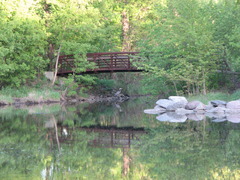
The largest bird we see regularly at Gervais Mill Park is the Great Blue Heron. It is a very large, unmistakable bird. There is almost always at least one feeding at the ponds from shortly after ice-out in the spring, until about a month or so before the ponds freeze up in the late fall. Many of these birds probably nest at the heronry a few miles north of us on Lake Peltier.
Great Blue Herons regularly commute (up to 25 miles) from nesting sites to feeding sites, and I constantly see them in transit across the skies of the Twin Cities. While caring for nestlings they must make several round-trips per day, and based on the numbers I see in transit, I can believe it.
The photograph I’ve used at the top of this page is one of my favorites. If you click on the thumbnail to see a larger image, you might understand why. It’s not the best picture of a bird, but the photo of the heron, bridge, and pond is nice, I think. There are of course photos below that are more bird, less wannabe-Monet. Also, don’t miss the fascinating Great Blue Heron-related footnote.[1]
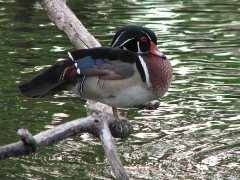
Every year two or three female Wood Ducks nest in Gervais Mill Park. They use nest boxes that were constructed and placed by a local Boy Scout troop. For the past couple of years I’ve cleaned and performed minor repairs on these boxes, which is a small price to pay for the chance to see these colorful birds thrive on the ponds.
As is the case with the Great Blue Heron, I don’t have a specific recollection of the first Wood Duck I saw in the park (it seems now that I’ve just always seen them there). It was in May, though, and was probably a brightly-colored male just coming into his full breeding plumage.
I took the photo of the male Wood Duck shown above in Audubon Park in New Orleans, Louisiana in April of 2008. More photos of the two species featured here are found below. Some bonus Wood Ducky content is available in footnotes.[2]
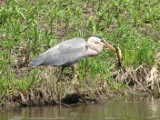
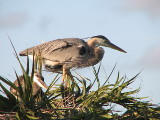
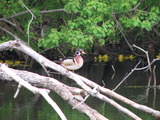
| Species | Great Blue Heron / Ardea herodias |
| Species | Wood Duck / Aix sponsa |
| Where | Gervais Mill Ponds, Little Canada, MN |
| When | May 2004 |
| With | Joann |
| Number | 34 - 35 |
See lifebird index.

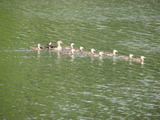

—
Notes
- On May 13, 2013, Joann and I took my dad to Crosby Farm Park in St Paul with hopes of finding a nesting pair of Prothonatary Warblers as we had a year earlier there. We had no such luck, but we did make a jaw-dropping sighting.
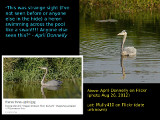
I don’t recall which of saw it first: a Great Blue Heron floating high on the water of a small lake. We refused to believe it. “It must be standing on an underwater stump or something,” said one of us. Though its posture should have convinced us otherwise. We all had seen many GBHEs without seeing this, and none of us had read or heard of this behavior. After a few minutes of watching the bird and speculating about how this must be some sort of illusion, it flapped its wings—very much like a swan preparing to take off—then lifted itself into the air, flew lazily in a semicircle over the lake, and then landed on a different spot far from the shore of the lake. Whereupon it folded its wings and settled comfortably into a swanlike pose and floated again on the water.
None of us carried a camera that day. I wasn’t successful in my quest to find this behavior described in bird guides or on the bird-nerdiest sites on the Internet. I am sure this information exists, though none of us has managed to find it or to hear from our birding friends that this is a thing. I did, however, find the two photos I’ve used to create the image here. Click or tap on it. [^]
 The mascot of Century College, where Joann teaches chemistry, is the Wood Duck. One can only imagine the intimidating effect the fierce Wood Duck has on Century’s sporting rivals. [^]
The mascot of Century College, where Joann teaches chemistry, is the Wood Duck. One can only imagine the intimidating effect the fierce Wood Duck has on Century’s sporting rivals. [^]
